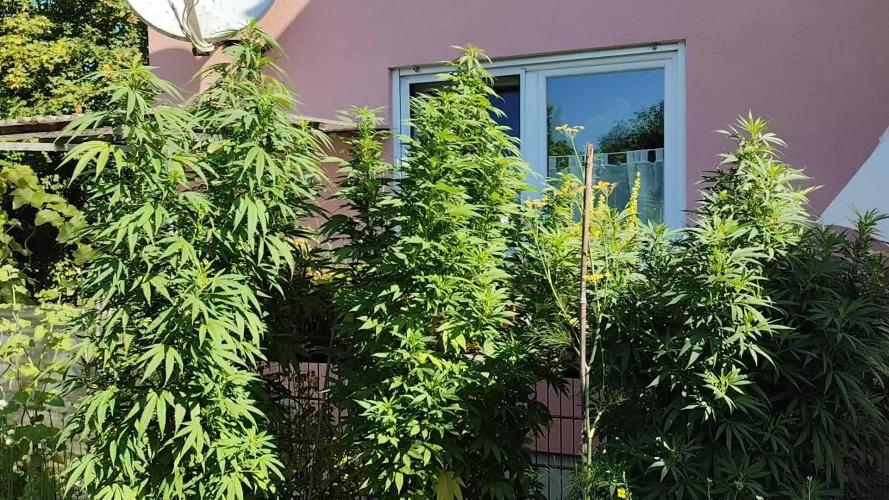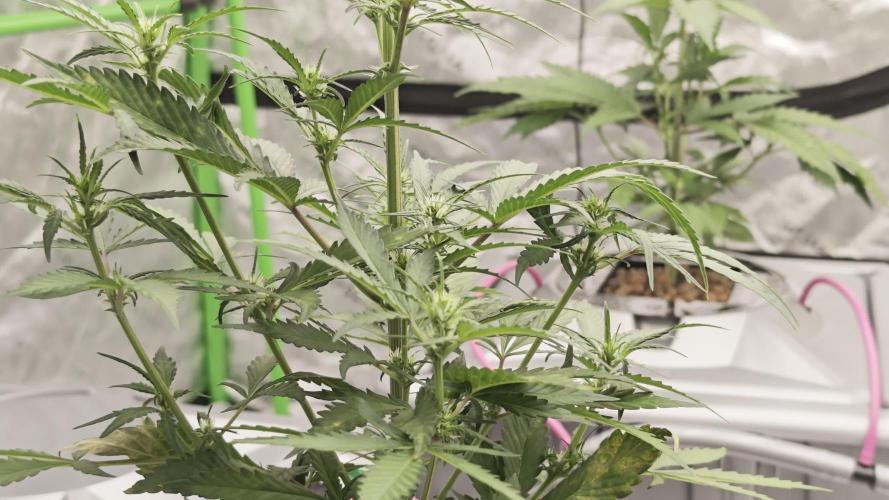The Grow Awards 2026 🏆 



































Likes
Comments
Share


@AestheticGenetix
Follow
5/12/2024 happy Mother’s Day to all the ladies and buds
5/15 super frosty sugar leaves. I can visually see them standing, that they are so tall
5/18 end of week 4
Likes
1
Share


@Skynets_Growing
Follow
Little Elsa my Ice princess Start in her 3 week and you can see she grow every day more and more with her leaves. Until day 20 i give her a light LST for 2 Leaves. The plan to do nothing to her except watering is blowing away … That will be not the only thing…you will see the next weeks. ^^
Likes
43
Share


@Sabac
Follow
Plantitas en su semana 12.
Crecen y crecen espero dejarlas entre 13 y 14 semanas.
Likes
32
Share


@Growbody
Follow
Hallo und herzlich willkommen zu meinem Growbericht Outdoor 2025 mit den Sorten Power Flower Feminized, Royal Medic Feminized und Special Kush #1 Feminized, alle 3 von Royal Queen Seeds. Es ist das erste Mal, das ich Töpfe für den Outdoor grow verwende, bisher waren alle Gorilla grows und direkt in die Erde gepflanzt.
Die URL der Power Flower Feminized: https://www.royalqueenseeds.de/feminisierte-hanfsamen/120-power-flower.html
Die URL der Royal Medic Feminized: https://www.royalqueenseeds.de/cbd-samen/148-royal-medic.html
Die URL der Special Kush #1 Feminized: https://www.royalqueenseeds.de/feminisierte-hanfsamen/138-special-kush-1.html
Die Planung für den Grow ist, die Samen in easyplug Anzuchtwürfeln keimen zu lassen und danach in 0,6L und 2,2L Plastiktöpfen, dann letztlich in die neuen komplett doppellagigen ROOTIES 15 Liter Wide Version Stofftöpfe umzutopfen. Sobald die Witterung es zuläßt, sollen die Pflanzen an die frische Luft.
Es ist schon eine Weile her, das der Grow losging, die Bilder sind jetzt aktuell.
Tag 171: Die drei Großen in der Morgensonne. Vorgestern kam dann doch noch der ersehnte Regen, erst massiv, es hat geschüttet wie aus Eimern, dann über die Nacht schöner Landregen, kein Hagel. Der Bach hat wieder Wasser, der Brunnen bleibt zu. Die Power Flower fem. misst jetzt 205 cm, die Special Kush fem. 200 cm und die Royal Medic fem. 160 cm.
Wenn's dir gefallen hat, schau wieder vorbei ✌️😎
Likes
24
Share


@Ganjaman19
Follow
Week 2 flower is over and things are looking great I really love the future harvest development range always pushing your plants to the max with @adyfutureharvestuk @Hydroprowashington with the best stuff about make sure you follow them on Instagram
Cant wait to see how these finish up and if anyone can recommend any beans if should try next time feel free to drop me a message anytime or contact me on my IG @Washingtonblazers
Thanks as always to my sponsors
@Anesiaseeds @divineseeds
@HydroproWashington and my newest one @inseediousseeds
And @HydroproWashington for the awesome range of Nutrients see you'd next week team
Likes
9
Share


@Dormando
Follow
Diagnosed during mid to late flowering that the Soil and feeding pH throughout the grow was what out of range. I was feeding 4.5 pH acid fert solution and 7.3pH tap water. Although the soil had the nutrients, plant couldn't use it because the pH was way out of range.
Yield was PRETTY GOOD though ! 80G's for first time rookie grower, despite of deficiencies in late flowering, its good. I wonder how thick and resinous the buds will grow if grown properly !
Definitely indica dominant straint. NOT for DayTime ! Amazing for night time dabs !
Likes
38
Share


@CANNASIM
Follow
---GENERAL COMMENT---
Girls are at day 4 technically, but i like to update Sunday always, so keep that in mind, is 1/2 a week now.
From germination to soil emerging took 3-4 days, no issues at all. 100% germination rate from multiple breeders till now.
I will try my best to do a stress free grow again, so will grow mainly naturally.
---RQS EASY BUD---
Ironically the Easy bud is developing better and growing faster than her sister.
---DAY 10 UPDATE---
Over some days she got volume, just started to use RECHARGE, and wow, that thing works, 48H you could tell something is different, since watering with it the stem is thicker and is growing more vigorous, lets see how it will impact overall!
---DAY 14 UPDATE. WEEK 2 FINAL---
This is the last day of this week and this girl is absolutely amazing, she grew a lot, showing already the intension of shooting up more stems, i'm very happy with her, it has been a delight to grow, response in very good. Voodoo juice is of by now, will keep the recharge maintenance every other watering as i'm loving it.
Feeding program will start soon!
Likes
23
Share


@Grumpygrower121
Follow
04-08-2023 day 8
The girls are in full stretch ,filling the top trellis and about to explode into bloom.
04.09.2023 Day 9
I am flabbergasted as I sit here. Never before have I grown a plant were the terps were so fragrant that I could smell them at day 9 from several feet away. Absolutely amazing!!
04.11.2023 Day 11
All 3 cuts have rooted and are now Planted. The Plants are stretching pretty hard .
Likes
4
Share


@nijuana
Follow
I had some potassium/phosphorus deficiencies due to the very fast change from veg to flower
Likes
28
Share


@Chubbs
Follow
420Fastbuds
FBT2307 Week 9
What up fellow growers. Weekly update for these three amazing girls. All seem to be growing good even the one to the left that's been fighting me the whole grow. The other two's flower sites are swelling up nice at this stage of flower. The middle one has decided to go into beast mode since transitioning into flower showing growth daily. Over all no big issues to be to worried about getting some fade/yellowing in the leafs but over all Happy Growing.
Likes
109
Share


@MadeInGermany
Follow
Welcome to the Green House Company Cup 🏆.
Day 41 since time change to 12/12.
Hey everyone .
It smells better and sweeter every day 😍.
Your buds are developing beautifully 😄.
The look of the buds is also beautiful.
She takes her GHSC Powder Feeding very well, so I'm really excited about the stuff ☺️. Very easy to feed.
It doesn't take too long until these beautiful flowers reach their end ✌️🏼.
I am very curious how I will like this variety and especially how it will taste 😃.
I wish you all a lot of fun with the update, stay healthy 🙏🏻, and let it grow 😛
You can buy this Strain at :
https://greenhouseseeds.nl/
☝️🏼☝️🏼☝️🏼☝️🏼☝️🏼☝️🏼☝️🏼☝️🏼☝️🏼☝️🏼☝️🏼☝️🏼
Green House Seeds Company Cup 🏆
Type:
Wonder Pie
☝️🏼
Genetics:
Wedding Cake x OG Kush
👍😍
Vega lamp: 2 x Todogrow Led
Quantum Board 100 W
💡
Flower Lamp : 2 x Todogrow Led
Cxb 3590 COB 3500 K 205 W
💡💡☝️🏼
Earth: Canna Bio
☝️🏼
Fertilizer: Bio Grow Feeding ( GHSC ) , Enhancer ( GHSC ) , Bio Bloom ( GHSC)
☝️🏼🌱
Water: Osmosis water mixed with normal water (24 hours stale that the chlorine evaporates) to 0.2 EC. Add Cal / Mag to 0.4 Ec Ph with Organic Ph - to 6.0
Likes
77
Share


@SooSan
Follow
Grosse grosse defoliation
Remise en place des branches
Et passage en flo !
Dans l'ordre:
1) Afghan Peach x Blue Monkey
2) Gelato Cake
3) Fast Critical Poison
4) Tropical Fuel
5) Hindu Kush
6) (Blueberry x Black Domina) X (Kosher Kush x Mk-Ultra)
7) Blueberry
8) Herz OG
9) (Blueberry x Black Domina) X (Kosher Kush x Mk-Ultra)
Likes
6
Share


@wheedtobeus420
Follow
In the dark Ice flushing looking beautiful. We added another family member his name is Mortimer 😍🐷 will be getting the chop soon
Likes
38
Share


@Snakeking
Follow
2 of plants started fading a little
I feed them with compost tea and organic nutrients of biobizz
I want to test something on one of my plants.
Light Compost tea 2 times a week
I fed them compost tea once a week from early veg until now and there is no sign of nutrients burning its 33 degrees celsius they need watering everyda
Likes
11
Share


@HegauHillsFarmers_M11
Follow
Tag 35 - Ende der 5. Woche.
In dieser Woche an Tag 33 habe ich die Pflanze etwas entlaubt. Dabei habe ich die untersten Triebe entfernt und zusätzlich alle weiteren Blätter die im unteren Bereich nur im Schatten standen entfernt um die Luftzirkulation zu verbessern und die Belichtung zu erhöhen. Die Pflanze ist voll im Stretch und hat diese Woche nochmal ordentlich an Höhe dazu gewonnen.
Die Blüten entwickelt sich gut und wachsen.
An Tag 29 wurde die Pflanze gedüngt.
Nährstofflösung:
2 ml/l - Voodoo Juice Advanced Nutrients.
4 ml/l - pH Perfect Sensi Bloom Part A
4 ml/l - pH Perfect Sensi Bloom Part B
2 ml/l - Bud Candy Advanced Nutrients.
Davon hat die Pflanze 500ml an Tag 29 erhalten.
Likes
5
Share


@Do_it_Dan
Follow
She's starting to fatten up now and she's getting rather greedy for water, fed 3 litres yesterday and today she's feeling a little light so probably feed in another 2 days, I'm happy she's happy were all happy 😊 l, happy growing and stay green ✌️ 💚 👌
Likes
11
Share


@AtticGrowing
Follow
Very strong genetics on this one, I would definitely grow it again for those dense buds fully covered in trichomes.
Thanks to the FastBuds team for the seeds!
Processing
Likes
28
Share


@Salgeezi
Follow
Plants are almost done. Feeding at 400 EC. Slowly getting them ready for flush. The front right lady seems to be about a week behind but it's okay. Shell get cut last.























